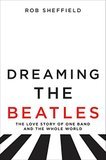Review of Rob Sheffield's Dreaming The Beatles 7 of X: Anatomy of a Ride
 Been a bit since I posted a review of Rob Sheffield's Dreaming the Beatles (some 13 days), mostly because this is not a book to be rush-read or even normally read (whatever pace that might be), but savored, and also because I've been writing some science fiction, and there's also the lure of the cool water and soft beach of Cape Cod Bay. But I wanted to record a few words about Sheffield's chapter on "Ticket to Ride", about as rich and satisfying an extended analysis you can find of a Beatles or any worthy song.
Been a bit since I posted a review of Rob Sheffield's Dreaming the Beatles (some 13 days), mostly because this is not a book to be rush-read or even normally read (whatever pace that might be), but savored, and also because I've been writing some science fiction, and there's also the lure of the cool water and soft beach of Cape Cod Bay. But I wanted to record a few words about Sheffield's chapter on "Ticket to Ride", about as rich and satisfying an extended analysis you can find of a Beatles or any worthy song.I recall well when "Ticket to Ride" came out in the Spring of 1965. My friends and I - especially our group, on its way from The Transits to The New Outlook - knew immediately that "Ticket to Ride" was something different. It had an edge, an imminence, a truth that none of the Beatles' songs quite had before. (The B-side, "Please Don't Wear Red" aka "Yes It Is," is a masterpiece, too, and a personal favorite. Not mentioned by Sheffield in this chapter, but it plays a crucial role in my 1997 Loose Ends.)
Back to "Ticket to Ride" - Sheffield tells us why. It's a song about an adult relationship - Lennon is living with this woman. It's a song pointed at a unique stage in their relationship - she wants to leave, she's bought a ticket to leave, but she hasn't left yet. Maybe she won't leave (unlikely), maybe she'll come back (also unlikely), the only unambiguous note in this story is that she's deeply unhappy about living with John. And as Sheffield aptly says, John is not arguing with her, trying to convince her to stay, he's just at the beginning of trying to understand this.
You just don't usually find relationships at this stage and presented at this level of complexity and ambiguity in love songs, although they are the marrow of real life. This song also checks in on a quiet tally I've been keeping in my head for more than a half a century: can a love song be as socially significant as a song aimed at some social injustice? Dylan's "Just Like A Woman" is one, rare example (so are some of Cole Porter's best works) - but it came a year after "Ticket to Ride". So the Beatles in terms of socially significant love songs got there first, and these two songs are all the evidence one needs that not all love songs are silly, or even just medium wise.
Sheffield also offers more testimony on behalf of George Martin's deft production skills, remarking on the perfect mix of McCartney's harmony on this track, so it provides resonance to Lennon's introspection without intruding on it.
And I'll be back sooner or later with another review.
See also Review of Rob Sheffield's Dreaming the Beatles 1 of X: The Love Affair ... 2 of X: The Heroine with a Thousand Faces ... 3 of X: Dear Beatles ... 4 of X: Paradox George ... 5 of X: The Power of Yeah ... 6 of X: The Case for Ringo
Paul Levinson's books ... Paul Levinson's music
Published on June 18, 2017 09:46
No comments have been added yet.
Levinson at Large
At present, I'll be automatically porting over blog posts from my main blog, Paul Levinson's Infinite Regress. These consist of literate (I hope) reviews of mostly television, with some reviews of mov
At present, I'll be automatically porting over blog posts from my main blog, Paul Levinson's Infinite Regress. These consist of literate (I hope) reviews of mostly television, with some reviews of movies, books, music, and discussions of politics and world events mixed in. You'll also find links to my Light On Light Through podcast.
...more
- Paul Levinson's profile
- 342 followers



